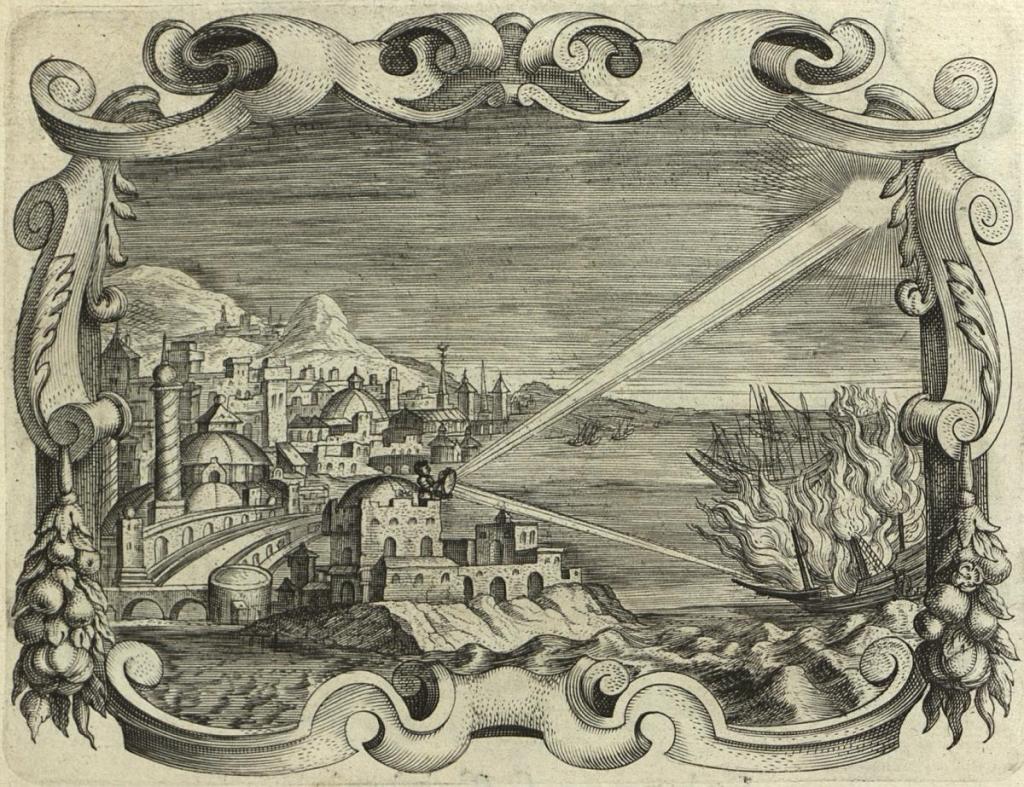Despite all the doubts surrounding the historical veracity of the episode in which the Greek philosopher Archimedes used a mirror, placed in one of the towers of the port of Syracuse, as a weapon to set fire to the ships of a Roman fleet, these did not prevent it from attracting a continuous interest from the scientific community.
Among the Jesuits, caustic lenses, or rather, the properties of glass in focusing light rays to cause combustion at a distance, were the subject of successive approaches, particularly after the publication, in 1613, of a lecture by Francisco de Guevara, the Spanish pupil of the mathematician Christoph Grienberger in the Roman College.

In the following decades, Archimedes’ mirrors did not escape the attention of the Jesuits Athanasius Kircher and Gaspar Schott, serving as a background for the discussion of the influence of the shape of the lenses on the concentration and reflection of the light rays and on the maximum distance in which this phenomenon could occur.
At the same time, the Archimedes’ caustic mirrors were brought to the world of erudite emblems by Jan David. In his work Duodecim Specula, twelve different properties of reflection are compared with many other stages of spiritual asceticism, in a path for the salvation of the soul. Among the themes for the meditation of the third stage, the old Greek philosopher carries a mirror in his hands, in his battle of light against the dark enemies.
The same idea of burden mirrors as a weapon, now against the enemies of the Christian faith, served to illustrate one of the emblems of the work Imago Primi Saeculi Societatis Iesu, published for the Society’s centenary celebrations, in 1640.
With the motto Caelestibus armis eminus expugnat [A heavenly weapon conquers distance], the emblem made an apology for the oratory talents of the Society’s founder. In this metaphor, the sermons of Ignatius of Loyola, ignited by the heavens, are compared to the Archimedes’ weapon in a war against the Christian enemies.
Both in the panel tiles of the physics class at the Colégio do Espírito Santo and the mathematics class in the Aula da Esfera, the Archimedes weapon established a bridge between the sciences and the successful evangelizing activity of the Jesuits.
ESSENTIAL BIBLIOGRAPHY
BOLLAND, Johannes; TOLLENAERE, Jean de; HOSSCHE, Sidronius de; WALLE, Jacques van de & FRUYTIERS, Philip. Imago Primi Saeculi Societatis Iesu: a prouincia Flandro-Belgica eiusdem Societatis repraesentata. Antuérpia: Balthasaris Moreti, 1640.
MENDEIROS, José Filipe. Os azulejos da Universidade de Évora. Tiles of the University of Evora. Évora: Universidade de Évora, 2002.



3 replies on “Science as a Christian Weapon”
Are you blogging in 2023? I’d love to read about historical reference to those who arrive in Portuguese in travel.
LikeLike
Hello, thanks for the comment. In 2023, we continue to produce short texts about the art of “azulejo” in Portugal.
LikeLike
I’m all in for Porto next year with our travel plans. I will stay tuned to your blog.
LikeLike